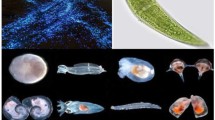Abstract
In this article, we apply different functional responses to introduce new mathematical feature in marine ecosystem. Strength of phytoplankton refuge and zooplankton refuge play big impacts in our system. We examine the different bifurcation scenarios when one or two different parameters vary together at the same time. A comparison of deterministic and stochastic approaches for analyzing the system dynamics are adopted. Analytical as well as numerical simulations are carried out to establish our findings.
Access this chapter
Tax calculation will be finalised at checkout
Purchases are for personal use only
Similar content being viewed by others
References
S. Khajanchi and S. Banerjee, Role of constant prey refuge on stage structure predator–prey model with ratio dependent functional response. Applied Mathematics and Computation 314, 193–198 (2017).
X. **e, Y. Xue, J. Chen and T. Li, Permanence and global attractivity of a nonautonomous modified Leslie-Gower predator-prey model with Holling-type II schemes and a prey refuge. Advances in Difference Equations 2016(1), 1–11 (2016).
S. Khajanchi and S. Banerjee, Role of constant prey refuge on stage structure predator–prey model with ratio dependent functional response. Applied Mathematics and Computation 314, 193–198 (2017).
M. Haque, S. Rahman, E. Venturino and B. L. Li, Effect of a functional response-dependent prey refuge in a predator–prey model. Ecological Complexity 20, 248–256 (2014).
D. Jana and S. Ray, Impact of physical and behavioral prey refuge on the stability and bifurcation of Gause type Filippov prey-predator system. Modeling Earth Systems and Environment, 2(1), 24 (2016) https://doi.org/10.1007/s40808-016-0077-y.
A. Das and G. P. Samanta, A prey-predator model with refuge for prey and additional food for predator in a fluctuating environment. Physica A: Statistical Mechanics and its Applications 538, 122844 (2020).
W. Zhang and M. Zhao, Dynamical Complexity of a Spatial Phytoplankton-Zooplankton Model with an Alternative Prey and Refuge Effect. Hindawi Publishing Corporation Journal of Applied Mathematics Volume 2013, Article ID 608073 (2013).
J. Li, Y. Song, H. Wan and H. Zhu, Dynamical analysis of a toxin-producing phytoplankton-zooplankton model with refuge. Mathematical Biosciences and Engineering 14(2), 529–557 (2017).
W. Sun, S. Dong, X. Zhao, Z. Jie, H. Zhang, and L. Zhang, Effects of zooplankton refuge on the growth of tilapia (Oreochromis niloticus) and plankton dynamics in pond. Aquaculture international 18(4), 647–655 (2010).
M. Bandyopadhyay and J. Chattopadhyay, Ratio-dependent predator-prey model: Effect of environmental fluctuation and stability. Nonlinearity 18 , 913–936 (2005).
T. Liao, C. Dai, H. Yu, Z. Ma, Q. Wang and M. Zhao, Dynamical analysis of a stochastic toxin-producing phytoplankton–fish system with harvesting. Advances in Difference Equations 2020(1), 1–22 (2020).
Z. Chen, S. Zhang and C. Wei, Dynamics of a stochastic phytoplankton-toxin phytoplankton–zooplankton model. Advances in Difference Equations, 2019(1), 1–18 (2019).
H. Liu, C. Dai, H. Yu, Q. Guo, J. Li, A. Hao, J. Kikuchi and M. Zhao, Dynamics induced by environmental stochasticity in a phytoplankton-zooplankton system with toxic phytoplankton. Mathematical Biosciences and Engineering, 18(4), 4101–4126 (2021).
W. W. Murdoch and J. Bence, General predators and unstable prey populations, in: Predation: direct and indirect impacts on aquatic communities. (W. C. Kerfoot and A. Sih, eds.), University Press of New England, Hanover, 17–30 (1987).
A. Chatterjee and S. Pal, Dynamical Analysis of Phytoplankton–Zooplankton Interaction Model by Using Deterministic and Stochastic Approach. In: Mondaini R.P. (eds) Trends in Biomathematics: Chaos and Control in Epidemics, Ecosystems, and Cells. BIOMAT 2020. Springer, Cham, 33–56 (2021).
P.K. Tapaswi and A. Mukhopadhyay, Effects of environmental fluctuation on plankton allelopathy, J. Math. Biol. 39, 39–58 (1999).
E. Beretta, V.B. Kolmanowskii and L. Shaikhet, Stability of epidemic model with time delays influenced by stochastic perturbations, Math. Comp. Simul. 45 (3-4), 269–277 (1998).
I.I. Gikhman and A.V. Skorokhod, The Theory of Stochastic Process-I, Springer, Berlin, (1979).
L. Shaikhet, Lyapunov Functionals and Stability of Stochastic Functional Differential Equations. Springer, Dordrecht, Heidelberg, New York, London, 2013.
V.N. Afanas’ev, V.B. Kolmanowskii and V.R. Nosov, Mathematical Theory of Control Systems Design, Kluwer Academic, Dordrecht, (1996).
M. Bandyopadhyay and J. Chattopadhyay, Ratio-dependent predator-prey model: Effect of environmental fluctuation and stability, Nonlinearity 18, 913–936 (2005).
S. Pal and A. Chatterjee, Dynamics of the interaction of plankton and planktivorous fish with delay. Cogent Mathematics 2(1), 1074337 (2015).
Author information
Authors and Affiliations
Editor information
Editors and Affiliations
Rights and permissions
Copyright information
© 2022 The Author(s), under exclusive license to Springer Nature Switzerland AG
About this chapter
Cite this chapter
Chatterjee, A., Pal, S. (2022). Implementation of the Functional Response in Marine Ecosystem: A State-of-the-Art Plankton Model. In: Mondaini, R.P. (eds) Trends in Biomathematics: Stability and Oscillations in Environmental, Social, and Biological Models. BIOMAT 2021. Springer, Cham. https://doi.org/10.1007/978-3-031-12515-7_5
Download citation
DOI: https://doi.org/10.1007/978-3-031-12515-7_5
Published:
Publisher Name: Springer, Cham
Print ISBN: 978-3-031-12514-0
Online ISBN: 978-3-031-12515-7
eBook Packages: Mathematics and StatisticsMathematics and Statistics (R0)




